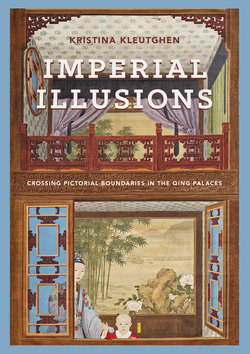Читать книгу Imperial Illusions - Kristina Kleutghen - Страница 82
Оглавлениеtheir simplified illustration in The Study of Vision. Throughout the treatise, only in very rare cases do Nian’s instructions identify the subjects of the illustrations; instead, they presume that the reader recognizes them, and therefore focus on the method necessary to create those subjects. But methods are presented in only a minority of the illustrations, leaving the reader to infer the method based on the previous forms, and they are far from transparent, requiring not only advanced mathematical knowledge, but also familiarity with and willingness to use technical drawing tools. What Nian’s concluding comment in this passage and the significantly higher number of illustrations than explanations in the treatise do show, however, is that Nian believed images conveyed more information than text. He thus provides the very methodology with which to engage The Study of Vision.
The second section of The Study of Vision (19r–23v) includes thirty-four individual illustrations depicting the use of distance-point perspective to create a variety of architectural forms, including rooms with paved floors in the European pavimento treatment of perspective (figure 2.4), also seen in the scenic illusion version of Spring’s Peaceful Message. Unlike the central-point method of perspective, the distance-point method creates perspectival images by triangulating the vanishing point (which Nian commonly refers to as the toudian or zhengtoudian, “head point” and “main head point,” respectively) from two lateral distance points (lidian, literally “distance point”), the distances between which are equivalent to the original viewing distance from the eye’s viewpoint and the picutre plane.50 Viator (Jean Pelerin, c. 1425–before 1524) first described the distance-point or “third-point” (tier point) system in a series of diagrams without significant text in De artificiali perspectiva (Toul, 1505), the first illustrated perspective treatise. It informed subsequent authors such as Jean Cousin the Elder (1500–93) and Jacopo Barozzi da Vignola (1507–73), who further developed both the theory and the praxis of distance-point perspective. Viator, Cousin, and Vignola were among the authors of the numerous perspective treatises held in the eighteenth-century Jesuit library in Beijing.51 The illustrations in many of these treatises, including Guidobaldo del Monte’s (1545–1607) Perspectivae librae sex (Pisa, 1600) and Sebastiano Serlio’s (1475–1554) Architeturae liber septimus (1537–75), have been linked to those in The Study of Vision.52 These visual connections imply that Nian enjoyed significant access to the Jesuit library, although someone (almost certainly a Jesuit) must have translated or at least explained the texts to him, as Nian neither spoke nor read any Western languages. The Jesuit library does not seem to have held a copy of Jean Dubreuil’s (1602–70) La perspective pratique (1642), yet several of the illustrations from this second section of The Study of Vision closely resemble some in this French treatise.53 European authors of perspective treatises freely and frequently borrowed both images and text from other treatises, often without crediting their sources.54 It is quite likely that Nian encountered variations on Dubreuil’s images in other treatises, but by never mentioning the fact that he had studied and borrowed from them, he unwittingly followed in this tradition.
